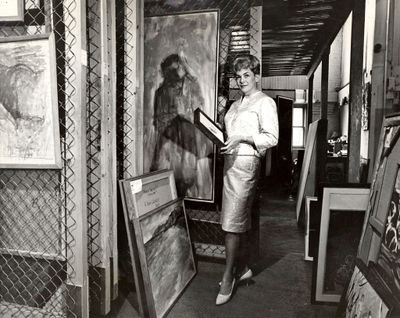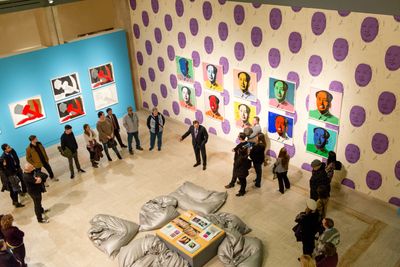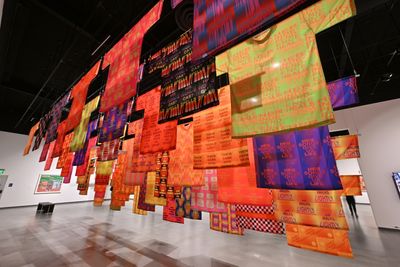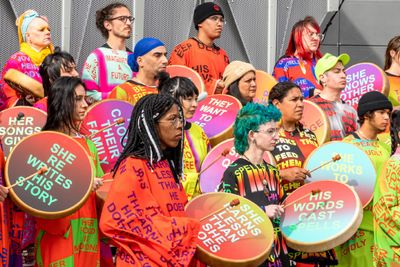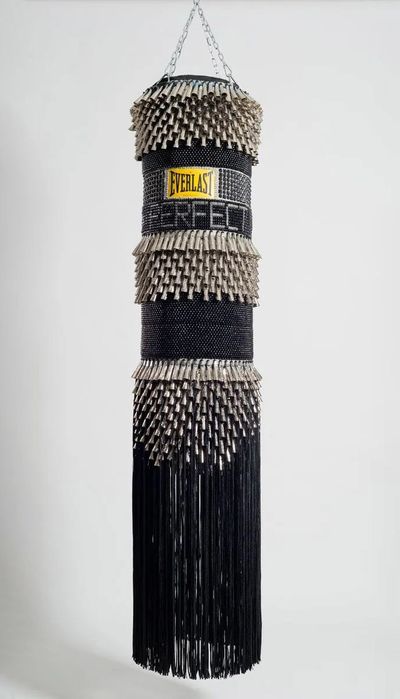
26 Nov Collector Spotlight: Jordan Schnitzer
Source Credit: Content and images from Ocula Magazine. Read the original article - https://ocula.com/magazine/features/collector-spotlight-jordan-schnitzer/
The American collector spoke to Ocula about his eponymously named family foundation, which has amassed over 22,000 artworks, and its recent focus on Jeffrey Gibson.
Jordan Schnitzer explains over the phone that he came across Gibson’s work at the Whitney Biennial in 2019. He was moved by the artist’s boldly coloured textiles and sculptures, which draw upon a wide range of references, including Choctaw, Cherokee, and queer histories.
Within days, he had contacted Gibson’s then-dealer, Kavi Gupta, and bought most of everything he had. When pressed about what drew him to Gibson’s work, Schnitzer replies, ‘You just know, and you get it done.’ That encounter began a long-term commitment to the artist, with Schnitzer adding over 40 works to his collections over the next five years.
Jeffrey Gibson, Stand Your Ground (2019). Exhibition view: Jeffrey Gibson: They Teach Love, From the Collections of Jordan D. Schnitzer and his Family Foundation, Bernard A. Zuckerman Museum of Art, Kennesaw State University (27 August–7 December 2024). Photo: Mike Jensen.
Among the works shown at the Whitney and subsequently purchased by Schnitzer was Stand Your Ground (2019): two boldly coloured, ceiling-hung banners emblazoned with the titular expression. The banners reference U.S. legislation, also known as the ‘Shoot First’ law, allowing citizens to use deadly force when they feel threatened.
Stand Your Ground is included in a major travelling exhibition, Jeffrey Gibson: They Teach Love, From the Collections of Jordan D. Schnitzer and His Family Foundation, at Bernard A. Zuckerman Museum of Art, Kennesaw State University. The show presents pieces from Schnitzer’s personal and foundation collections, allowing American audiences to experience the breadth of Gibson’s work. This year, Gibson represented the U.S. at the Venice Biennale, a first for an Indigenous artist.
Exhibition view: Jeffrey Gibson, the space in which to place me, United States of America Pavilion, The 60th International Art Exhibition, La Biennale di Venezia, Venice (20 April–24 November 2024). Courtesy La Biennale di Venezia. Photo: Matteo de Mayda.
In person, Schnitzer is polite and absolutely to the point, and his commitment to American artists—whose work he follows avidly, amasses in depth, and exhibits widely—appears to be characterised by a relentless drive.
He begins our discussion by covering the numbers quickly: the Jordan D. Schnitzer Family Foundation Collection includes close to 22,000 paintings, prints, and sculptures by some 1,500 artists. He has supported 180 exhibitions at 120 museums over the past 27 years. Asked why he thinks collecting is important, Schnitzer responds, ‘Art and artists are important; they are chroniclers of our times.’ As the interview nears its end, Schnitzer’s businesslike manner softens, and the passionate collector surfaces.
Arlene Schnitzer at Fountain Gallery. Courtesy Jordan Schnitzer Family Foundation.
Schnitzer grew up in Portland, Oregon, the son of Fountain Gallery founder Arlene Schnitzer and real-estate investment magnate Harold Schnitzer. Today, he runs the family business as president of Schnitzer Properties (formerly Harsch Investment Properties) and oversees the family’s philanthropic pursuits. His support of the arts also extends to the funding of Portland’s Converge 45 biennial and the annual IFPDA Jordan Schnitzer Award for Printmaking Excellence.
Schnitzer, who is now in his early 70s, was just 14 when he acquired his first piece of art—a 1965 painting titled Sanctuary by the late Portland artist Louis Bunce, which still hangs in his home. His interest in art can be traced to his mother, who opened Portland’s first commercial gallery in 1961 and ran the space for 25 years. As a result, Schnitzer spent time around local artists such as Bunce, whom his mother’s gallery represented. His family collection today reflects these roots, holding work by leading artists from Seattle, Portland, and San Francisco.
Exhibition view: Andy Warhol: Prints from the Collections of Jordan D. Schnitzer and His Family Foundation, Portland Art Museum (8 September 2016–1 January 2017). Courtesy Jordan Schnitzer Family Foundation.
In the 1980s, Schnitzer started collecting more concertedly, focusing on multiples by postwar American artists. In 2016, the foundation organised an exhibition of 250 of Andy Warhol‘s prints at Portland Art Museum—the largest presentation of the artist’s work in the U.S.—attended by more than 140,000 people.
Additionally, the foundation has an array of works currently featured in several museum shows as part of its commitment to lending works at no cost to the relevant institution. Currently, the foundation is supporting Amplitude (9 August–15 December 2024) at Eskenazi Museum of Art in Bloomington, which features prints by Terry Winters; The Only Way to Hold a Weight: Richard Serra Prints at the Jewish Museum in Portland (26 October 2024–15 January 2025); and David Hockney: Perspective Should Be Reversed at Palm Springs Art Museum (23 November 2024–31 March 2025).
David Hockney, 25th June 2022, Looking at the Flowers (Framed), edition 14/15 (2022). Photographic drawing printed on five sheets of paper, mounted on five sheets of Dibond. 299 x 518 cm (total). Collection of Jordan Schnitzer Family Foundation. Courtesy Jordan Schnitzer Family Foundation. Photo: Aaron Wessling.
The Schnitzer Collection is housed in a 50,000-square-foot, purpose-built facility in Portland, run by 14 full-time staff. Schnitzer buys from dealers, artists, and through auctions. Most recently, he explained that his collection has been focused on adding artworks by previously underrepresented and marginalised groups, notably women and Indigenous artists. In Schnitzer’s view, artists such as Hock E Aye Vi Edgar Heap of Birds, Malia Jensen, Wendy Red Star, and Gibson are making some of the best work today.
Exhibition view: Jeffrey Gibson, They Teach Love, From the Collections of Jordan D. Schnitzer and His Family Foundation, Jordan Schnitzer Museum of Art, Washington State University (22 August 2023–9 March 2024). Courtesy WSU Photo Services.
Gibson’s survey show opened at Jordan Schnitzer Museum of Art, Washington State University, in August 2023 before travelling to its current destination, where a talk was held on 17 October between the artist and collector.
Instigated before Gibson’s Venice representation was announced, They Teach Love grew out of a conversation between Schnitzer and museum director Ryan Hardesty. Each year, the institution organises one exhibition that draws from the foundation’s collection, with previous shows spotlighting American contemporary artists such as Alison Saar and Polly Apfelbaum.
Jeffrey Gibson, To Name An Other (2019–ongoing). Performance view: SITE Santa Fe Commission. Courtesy the artist and Kavi Gupta, Chicago. Photo: Shayla Blatchford.
The show’s centrepiece is To Name An Other (2019), which comprises 51 screenprinted elk-hide drums and 50 wearable garments. It is related to a performance commissioned by the Smithsonian’s National Portrait Gallery in Washington, D.C., which involved volunteers who identified as members of minority racial and sexual orientation groups performing in the clothing. The project, which saw the artist embrace a collective approach for the first time, marked a pivotal moment in Gibson’s career.
Upon seeing To Name An Other, Schnitzer explains that he was struck by Gibson’s ability to use garments and drums to present the sophisticated, astonishing beauty of his Choctaw and Cherokee culture. He was also left reeling from a sense of anguish at the losses Indigenous communities have suffered. He hopes the audiences who see the show may learn something of the history Gibson’s work references.
Jeffrey Gibson, I’m Not Perfect (2014). Found canvas punching bag, repurposed wool army blanket, glass beads, tin jingles, nylon fringe, artificial sinew, acrylic paint. 191.8 x 40.6 x 40.6 cm. © Jeffrey Gibson Studio. Photo: Marc Straus Gallery.
For Schnitzer, Gibson’s brilliance lies in his capacity to create a tension by both honouring and contemporising his culture and history while weaving in other references, including his journey as a queer person. He cites Gibson’s ‘Punching Bags’ series (2013–ongoing): dazzling beaded punching bags—inscribed with statements of resistance, frustration, and hope—as opening up many interpretive possibilities.
‘Every visitor brings to an exhibition the sum of who they are—a million different little mosaic parts of every experience they have ever had,’ Schnitzer says. ‘If just one person is touched by the art, if their life is perhaps changed for the better, or if they come to reflect on Gibson’s experience or the experience of Indigenous people, then I see the show as a success.’ —[O]
Source Credit: Content and images from Ocula Magazine. Read the original article - https://ocula.com/magazine/features/collector-spotlight-jordan-schnitzer/



